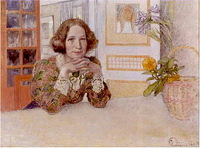Annastina Alkman was an expansive journalist who was an active member of the women’s movement.
Annastina Alkman grew up in Stockholm. She gained her basic education at the Åhlinska school, a private school for girls, and subsequently at the similarly private Palmgren co-educational school. The latter was the first secondary coeducational school in Scandinavia. After gaining her school-leaving certificate in 1899 Annastina Alkman studied music at the Kungliga Musikkonservatoriet (royal conservatoire of music) from 1897–1901. At the same time she also studied the sciences, initially at Stockholms högskola (college) and then at Uppsala university, where she gained her Bachelor’s degree in mathematics, astronomy, and mechanics in 1902. Apart from a brief stint as a mathematics teacher, she made her career as a journalist.
In 1902 Annastina Alkman began working as a volunteer for the Dagens Nyheter newspaper. Her entry onto the premises, wearing what later became a famous large-brimmed hat decorated with rowanberries, was legendary. Her tasks included writing feature articles, providing local reports on textile- and fashion-shows, and writing minor articles. Given that she had extensive linguistic skills she was also tasked with providing translations.
In 1905 Annastina Alkman married Edvard Alkman, who was the newspaper’s cultural editor. He had purchased the Göteborgs-Posten newspaper in 1904 and thus the couple subsequently moved to Gothenburg. Their two daughters were born there, first Eva – herself later a well-known journalist and children’s book reviewer, Eva von Zweigbergk – and in 1919 Lena, who died the same year. In 1926 Göteborgs-Posten faced bankruptcy, at which point Edvard Alkman handed it over to Harry Hjörne. Although the Alkman family then moved back to Stockholm Annastina Alkman carried on writing for Göteborgs-Posten.
During the Alkman couple’s ownership of the Gothenburg newspaper they put their heart and soul into the enterprise. Their extremely liberal approach left a heavy mark on the paper. Annastina Alkman expanded and developed the cultural journalism side of the paper and rapidly became a local bigwig. Her journalistic contributions included music reviews as well as theatre- and literary-reviews, along with numerous reports and interviews, whilst also comprising personal causerie-style columns. The main outlet for her social activism came through her reporting and her involvement in the women’s movement.
Annastina Alkman was extremely politically active – particularly within the women’s movement – and these activities intensified during her time in Gothenburg. She was a member of the Föreningen för kvinnans politiska rösträtt (FKPR) (association for women’s suffrage) which had been set up by Frigga Carlberg. Annastina Alkman was also one of the leading figures of the women’s movement in western Sweden. Further, she also played a significant role as chair of the local Föreningen frisinnade kvinnor (FFK) (liberal women’s association) set up by two female doctors, Ada Nilsson and Julia von Sneidern, in 1914. In 1921 Annastina Alkman was a delegate at the Women’s Peace Congress in Vienna. In 1926 she was also a participant at the tenth women’s suffrage congress in Paris. Annastina Alkman was elected honorary member of the Paris liberal women’s association in 1927.
Annastina Alkman was also artistically gifted. She continued to study music, translated textbooks, and eventually became a writer. Her memoires, entitled När gräset var grönt… and published in 1965, are a highlight of her literary output. She provided her own watercolours as illustrations for the book. Annastina Alkman made a very late debut as a watercolourist. At the age of 85 she held a solo exhibition at the Galleri Brinken in Stockholm. Her exhibition was a success and one of her watercolours was acquired by the National Museum.
Annastina Alkman died in 1971.












